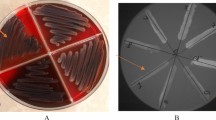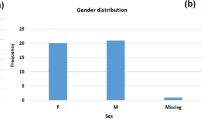Abstract
Klebsiella pneumoniae is an opportunistic pathogen responsible for nosocomial infections. Both resistance to multiple antibiotics and the expression of virulence factors are likely to be involved in the physiopathological process. In this study, 227 isolates of K. pneumoniae collected over a 1-year period in a teaching hospital in Clermont-Ferrand, France, were investigated for their antibiotic resistance pattern and the presence of several potential virulence traits. Enterobacterial repetitive intergenic consensus polymerase chain reaction (ERIC-PCR) indicated that most of the isolates were phylogenetically unrelated. When tested in an in vitro adhesion assay with Int-407 intestinal cells, the median adhesion index was 5.5×104 bacteria/cm2 (range, 2.0×102–3.4×105). Isolates resistant to cefoxitin, chloramphenicol, and quinolones showed significantly lower adhesion indexes. The frequency of mutagenesis conferring resistance to rifampicin was low for most of the isolates. The median mutagenesis frequency was 1.0×10−8 (range, 2.5×10−9–3.2×10−6) at 24 h and 1.1×10−8 (range, 1.8×10−9–1.2×10−5) at 7 days. In contrast, isolates resistant to cefoxitin, chloramphenicol, and tetracycline showed a significantly greater ability to mutate. These results suggest a link between adhesion capabilities and resistance to certain antibiotics. They furthermore indicate that strains with a high mutagenesis capacity are more likely to acquire antibiotic resistance genes. The high pathogenicity island of Yersinia was detected in 16.3% of the strains and was more often associated with isolates resistant to nalidixic acid and augmentin.


Similar content being viewed by others
References
Blot SI, Vandewoude KH, Colardyn FA (2002) Clinical impact of nosocomial Klebsiella bacteremia in critically ill patients. Eur J Clin Microbiol Infect Dis 21:471–473
De Champs C, Rouby D, Guelon D, Sirot J, Sirot D, Beytout D, Gourgand JM (1991) A case-control study of an outbreak of infections caused by Klebsiella pneumoniae strains producing CTX-1 (TEM-3) beta-lactamase. J Hosp Infect 8:5–13
Gruteke P, Goessens W, van Gils J, Peerbooms P, Lemmens-den Toom N, van Santen-Verheuvel M, van Belkum A, Verbrugh H (2003) Patterns of resistance associated with integrons, the extended-spectrum β-lactamase SHV-5 gene, and a multidrug efflux pump of Klebsiella pneumoniae causing a nosocomial outbreak. J Clin Microbiol 41:1161–1166
Podschun R, Ullmann U (1998) Klebsiella spp. as nosocomial pathogens: epidemiology, taxonomy, typing methods, and pathogenicity factors. Clin Microbiol Rev 11:589–603
Tseng YC, Chiu YC, Wang JH, Lin HC, Lin HC, Su BH, Chiu HH (2002) Nosocomial bloodstream infections in a neonatal intensive care unit of a medical center: a three-year review. J Microbiol Immunol Infect 35:168–172
Sirot D, Chanal C, Labia R, Meyran M, Sirot J, Cluzel R (1989) Comparative study of five plasmid-mediated ceftazidimases isolated in Klebsiella pneumoniae. J Antimicrob Chemother 24:509–521
De Champs C, Sirot D, Chanal C, Poupart MC, Dumas MP, Sirot J (1991) Concomitant dissemination of three extended-spectrum beta-lactamases among different Enterobacteriaceae isolated in a French hospital. J Antimicrob Chemother 27:441–457
Sirot J, Chanal C, Petit A, Sirot D, Labia R, Gerbaud G (1988) Klebsiella pneumoniae and other Enterobacteriaceae producing novel plasmid-mediated beta-lactamases markedly active against third-generation cephalosporins: epidemiologic studies. Rev Infect Dis 10:850–859
Di Martino P, Livrelli V, Sirot D, Joly B, Darfeuille-Michaud A (1996) A new fimbrial antigen harbored by CAZ-5/SHV-4-producing Klebsiella pneumoniae strains involved in nosocomial infections. Infect Immun 64:2266–2273
Di Martino P, Bertin Y, Girardeau JP, Livrelli V, Joly B, Darfeuille-Michaud A (1995) Molecular characterization and adhesive properties of CF29K, an adhesin of Klebsiella pneumoniae strains involved in nosocomial infections. Infect Immun 63:4336–4344
Favre-Bonte S, Licht TR, Forestier C, Krogfelt KA (1999) Klebsiella pneumoniae capsule expression is necessary for colonization of large intestines of streptomycin-treated mice. Infect Immun 67:6152–6156
De Champs C, Sauvant MP, Chanal C, Sirot D, Gazuy N, Malhuret R, Baguet JC, Sirot J (1989) Prospective survey of colonization and infection caused by expanded-spectrum beta-lactamase-producing members of the family Enterobacteriaceae in an intensive care unit. J Clin Microbiol 27:2887–2890
Selden R, Lee S, Wang WL, Bennett JV, Eickhoff TC (1971) Nosocomial Klebsiella infections: intestinal colonization as a reservoir. Ann Intern Med 74:657–664
Denamur E, Bonacorsi S, Giraud A, Duriez P, Hilali F, Amorin C, Bingen E, Andremont A, Picard B, Taddei F, Matic I (2002) High frequency of mutator strains among human uropathogenic Escherichia coli isolates. J Bacteriol 184:605–609
Oliver A, Canton R, Campo P, Baquero F, Blazquez J (2000) High frequency of hypermutable Pseudomonas aeruginosa in cystic fibrosis lung infection. Science 288:1251–1254
Carniel E (1999) The Yersinia high-pathogenicity island. Int Microbiol 2:161–167
Versalovic J, Koeuth T, Lupski JR (1991) Distribution of repetitive DNA sequences in eubacteria and application to fingerprinting of bacterial genomes. Nucleic Acids Res 19:6823–6831
Gutmann L, Williamson R, Moreau N, Kitzis MD, Collatz E, Acar JF, Goldstein FW (1985) Cross-resistance to nalidixic acid, trimethoprim, and chloramphenicol associated with alterations in outer membrane proteins of Klebsiella, Enterobacter, and Serratia. J Infect Dis 151:501–507
Favre-Bonte S, Darfeuille-Michaud A, Forestier C (1995) Aggregative adherence of Klebsiella pneumoniae to human intestine-407 cells. Infect Immun 63:1318–1328
Taddei F, Matic I, Radman M (1995) cAMP-dependent SOS induction and mutagenesis in resting bacterial populations. Proc Natl Acad Sci USA 92:11736–11740
Bach S, de Almeida A, Carniel E (2000) The Yersinia high-pathogenicity island is present in different members of the family Enterobacteriaceae. FEMS Microbiol Lett 183:289–294
Martinez-Martinez L, Hernandez-Alles S, Alberti S, Tomas JM, Benedi VJ, Jacoby G (1996) In vivo selection of porin-deficient mutants of Klebsiella pneumoniae with increased resistance to cefoxitin and expanded-spectrum cephalosporins. Antimicrob Agents Chemother 40:342–348
Andersson DI, Levin BR (1999) The biological cost of antibiotic resistance. Curr Opin Microbiol 2:489–493
Levin BR, Perrot V, Walker N (2000) Compensatory mutations, antibiotic resistance and the population genetics of adaptive evolution in bacteria. Genetics 154:985–997
Nagaev I, Bjorkman J, Andersson DI, Hughes D (2001) Biological cost and compensatory evolution in fusidic acid-resistant Staphylococcus aureus. Mol Microbiol 40:433–439
Philippon A, Arlet G, Jacoby GA (2002) Plasmid-determined AmpC-type beta-lactamases. Antimicrob Agents Chemother 46:1–11
Yong D, Park R, Yum JH, Lee K, Choi EC, Chong Y (2002) Further modification of the Hodge test to screen AmpC-lactamase (CMY-1)-producing strains of Escherichia coli and Klebsiella pneumoniae. J Microbiol Methods 51:407–410
Pérez-Pérez FJ, Hanson ND (2002) Detection of plasmid-mediated AmpC β-lactamase genes in clinical isolates by using multiplex PCR. J Clin Microbiol 40:2153–2162
Simonet V, Malléa M, Pagès JM (2000) Substitutions in the eyelet region disrupt cefepime diffusion through the Escherichia coli OmpF channel. Antimicrob Agents Chemother 44:311–315
Nikaido H, Basina M, Nguyen VY, Rosenberg EY (1998) Multidrug efflux pump AcrAB of Salmonella typhimurium excretes only those β-lactam antibiotics containing lipophilic side chains. J Bacteriol 180:4686–4692
Achouak W, Pages JM, De Mot R, Molle G, Heulin T (1998) A major outer membrane protein of Rahnella aquatilis functions as a porin and root adhesin. J Bacteriol 180:909–913
Hernandez-Alles S, Conejo M, Pascual A, Tomas JM, Benedi VJ, Martinez-Martinez L (2000) Relationship between outer membrane alterations and susceptibility to antimicrobial agents in isogenic strains of Klebsiella pneumoniae. J Antimicrob Chemother 46:273–277
Schnappinger D, Hillen W (1996) Tetracyclines: antibiotic action, uptake, and resistance mechanisms. Arch Microbiol 165:359–369
Kohler T, van Delden C, Curty LK, Hamzehpour MM, Pechere JC (2001) Overexpression of the MexEF-OprN multidrug efflux system affects cell-to-cell signaling in Pseudomonas aeruginosa. J Bacteriol 183:5213–5222
Hirakata Y, Srikumar R, Poole K, Gotoh N, Suematsu T, Kohno S, Kamihira S, Hancock RE, Speert DP (2002) Multidrug efflux systems play an important role in the invasiveness of Pseudomonas aeruginosa. J Exp Med 196:109–118
Vila J, Simon K, Ruiz J, Horcajada JP, Velasco M, Barranco M, Moreno A, Mensa J (2002) Are quinolone-resistant uropathogenic Escherichia coli less virulent? J Infect Dis 186:1039–1042
Hatfield GW, Benham CJ (2002) DNA topology-mediated control of global gene expression in Escherichia coli. Annu Rev Genet 36:175–203
Alekshun MN, Levy SB (1997) Regulation of chromosomally mediated multiple antibiotic resistance: the mar regulon. Antimicrob Agents Chemother 41:2067–2075
Chollet R, Bollet C, Chevalier J, Malléa M, Pagès JM, Davin-Regli A (2002) mar operon involved in multidrug resistance of Enterobacter aerogenes. Antimicrob Agents Chemother 46:1093–1097
Muhldorfer I, Hacker J (1994) Genetic aspects of Escherichia coli virulence. Microb Pathog 16:171–181
Carniel E, Mercereau-Puijalon O, Bonnefoy S (1989) The gene coding for the 190,000-dalton iron-regulated protein of Yersinia species is present only in the highly pathogenic strains. Infect Immun 57:1211–1217
Acknowledgments
This work was supported by grants from the “PRFMMIP—Réseau Infections Nosocomiales.” We thank Dominique Rubio for her technical assistance, Vincent Bige for helpful advice and Jeff Watts for revision of the English manuscript.
Author information
Authors and Affiliations
Corresponding author
Rights and permissions
About this article
Cite this article
De Champs, C., Rich, C., Chandezon, P. et al. Factors associated with antimicrobial resistance among clinical isolates of Klebsiella pneumoniae: 1-year survey in a French university hospital. Eur J Clin Microbiol Infect Dis 23, 456–462 (2004). https://doi.org/10.1007/s10096-004-1144-2
Published:
Issue Date:
DOI: https://doi.org/10.1007/s10096-004-1144-2




